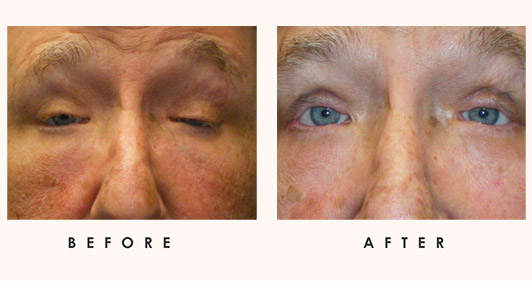LAGOPHTHALMOS
Jump To
Lagophthalmos, a condition where the eyelids cannot close completely, demands prompt attention. Effective management is essential for safeguarding eye health and averting further complications. At Idaho Eyelid & Facial Plastic Surgery, we provide comprehensive care, underpinned by the expertise of our leading dermatologists and oculoplastic surgeons.
What is Lagophthalmos?
Lagophthalmos is a medical condition characterized by the inability of the eyelids to close completely. This partial closure leaves the eye exposed, significantly increasing the risk of dryness, irritation, and even more severe damage to the eye’s surface. The condition is not singular in its origins; rather, it is categorized into several types based on its underlying causes:
- Paralytic Lagophthalmos: Caused by paralysis of facial nerves, leading to an inability to close the eyelids fully.
- Cicatricial Lagophthalmos: Results from scarring of the eyelid or surrounding tissues, which restricts eyelid movement.
- Mechanical Lagophthalmos: Occurs when physical obstructions or abnormalities prevent the eyelids from closing.
- Nocturnal Lagophthalmos: Happens during sleep, where the eyelids remain partially open, exposing the eye.
Symptoms of Lagophthalmos
Patients with lagophthalmos commonly report a range of discomforting symptoms that significantly impact their eye health and quality of life. These include:
- Eye Dryness: A persistent dry sensation due to inadequate moisture and tear coverage of the eye surface.
- Irritation: The feeling of discomfort or annoyance in the eyes, often described as a burning or stinging sensation.
- Grittiness: A sensation as if sand or another fine substance is in the eye, leading to discomfort.
- Excessive Tearing: Ironically, the eyes may produce more tears in response to the dryness and irritation, an attempt to lubricate the eye effectively.
- Light Sensitivity: An increased sensitivity to light, making bright environments uncomfortable or painful.
Diagnosis of Lagophthalmos
At Idaho Eyelid & Facial Plastic Surgery, we employ a meticulous diagnostic approach to accurately identify lagophthalmos and devise tailored treatment plans. This includes a detailed examination of the eyelids and eye surface for signs of damage, a comprehensive review of the patient’s medical history for underlying causes, and specialized testing to assess eyelid function and eye health. Our goal is to ensure that each patient receives personalized care based on their unique needs and conditions.
Treatment Options for Lagophthalmos
To alleviate symptoms and safeguard the eye from damage, we provide a range of treatment options tailored to the severity and specific needs of each patient:
- Non-surgical Treatments: For less severe cases, strategies like the consistent use of eye lubricants and securing the eyelid closed at night with medical tape can provide significant relief, maintaining moisture and protecting the eye.
- Surgical Treatments: In more complex or advanced instances of lagophthalmos, surgical options are considered. Procedures such as Tarsorrhaphy, where part of the eyelid is partially sewn together to reduce the eyelid opening, and the implantation of a Gold weight in the eyelid to aid its natural closure, are personalized treatments aimed at restoring eyelid function and eye protection.
Recovery and Aftercare
After undergoing surgical treatment for lagophthalmos at Idaho Eyelid & Facial Plastic Surgery, patients can expect a structured recovery period. Patients may experience mild to moderate discomfort, swelling, and bruising around the treated area, which generally subsides within the first few weeks. Downtime varies depending on the specific procedure performed, but patients are often advised to take it easy and avoid strenuous activities for a period, typically ranging from a few days to a couple of weeks.
Contact Us
Protect your vision against lagophthalmos. Contact Idaho Eyelid & Facial Plastic Surgery today to schedule your consultation and discover your treatment options with our skilled specialists. Your eye health is our top priority.



